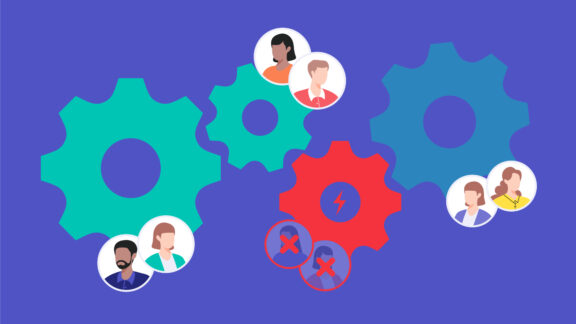These days, customers expect faster and faster results, even in a time when priorities and expectations can perpetually change and complexity can increase. The main driver of this development has been, and continues to be, the digital age. This means that the market conditions and the skills required can change at a moment’s notice.
Have we found the formula that can predict the future of a business? Absolutely not! What we have found, however, are businesses that consider how they can answer this increasingly rapid progress on the daily – in other words, how the operating system of a business has to look in order to always remain capable of handling these situations.
This article contains practical approaches that we have gleaned from conversations and analyses of the topic “Business Transformation”, as well as our own personal formula.
What Is Business Transformation?
In the 1990s, while working as consultants for Gemini Consulting, Francis J. Gouillart and James N. Kelly coined the term Business Transformation. In their book of the same name, they describe a practice-oriented method for restructuring businesses. Business Transformation is, for them, a fundamental shift in relationship management of a business: externally, with customers and partners, as well as internally with a company’s own employees.
In other words: businesses have to redefine their relationships and reshape their organizational structures in order to stay successful. By doing so, it is the responsibility of the company’s management to form a “vision”, which will serve as the basis upon which the business’ options will be weighed and decided.
Business Transformation Is Not a One Time Thing
Moore’s Law, established by Gordon Moore, the co-founder of Intel, states that technology develops exponentially – and we experience this development every day. Thus, it’s only logical that customers who live in this world shaped by progress, have expectations that develop at a similar pace.
Businesses therefore have to be sure that long-standing changes can take form faster and faster. This also means that employees should be set up to always further develop themselves and the company – without providing value for customers, suffer.
In spite of this, many businesses still implement methods from classic Change Management. Structures break, change, and freeze again in their new state. Managers and Human Resources departments guide people to the “right” position, only to “relocate” them later instead of changing their foundations preemptively. In this way, classic hierarchical working structures are preserved in most businesses.
Always-On Transformation as the New Standard
So, what can we do about this? In Beyond Great, the Boston Consulting Group speaks about a marriage between traditional organizations and agile, fluid teams, which uses perpetual change as a founding principal. For them “Always-On Transformation” means being practiced in consistently, and permanently, making many changes.
But there are people who support this system – especially those who work with clients. They have to make decisions, and they have to do so faster and faster. Through this process, employees can burn out or leave the business, and are difficult to replace – especially when word gets out that this is the case in the company. People who work together in a team today should successfully work together in another team tomorrow – without burnout. Conditions have to be established structurally and emotionally in order to achieve this.
Business Transformation Affects the Entire Company
Business Transformation, however, cannot be carried out by single units of a company. Particularly, with digital business models, all steps of the process have to be perfectly integrated with each other – from the first contact with the client to customer invoicing.
Spontaneously, companies first try to create a parallel structure for new products, ideas, and services. However, if capable employees are simply moved around the organization, the quality of service for existing customers deteriorates. But, if you don’t use the available resources, you may be missing out on the available knowledge.
When asked by the Boston Consulting Group, almost all of the surveyed companies said that exactly this balance between traditional business and new business models is incredibly important, but also incredibly difficult to implement.
Customers Have Been, and Remain, the Most Important
Companies want to add value to their customers as quickly as possible. In order to do this, they bring together people with the correct skills and give them the right tools. In the best case, those involved know each other, and like working with each other.
It is simply the case that added value needs to be created ever faster, in some cases even in real time. Customers expect high quality to be delivered at ever-increasing speeds. In turn, customers and employees are unhappy when decisions take too long or don’t deliver the expected benefits – for example, because they are made by management, and are thus too far away from the reality of the customer.
If customer expectations are to be met, then all operative decisions must be made by self-organized, independent teams.

Countering Complexity with Simplicity
People tend to design structures for complex issues that makes them seem less complex. However, the result can be complicated organizations which tend to do justice only for single ideas—by doing so, you hide the complexities and limit the natural development of companies and employees.
When you instead accept complexity as a given, it is easier to develop structures to deal with it. Management should not interfere with detailed decisions, but instead support self-organized teams. The job of company leadership is to achieve a vision and to provide the guidelines the organization needs to function today, as well as in the future.
Turning Mistakes into Opportunities
To this end, it’s important to establish a “mistake culture” that aims for continuous improvement, or even transformation. An error means that a better structure can subsequently emerge, better tools can be implemented in the future, or the skills of the employees may have evolved. This also means that employees who take on responsibilities in the realm of transformation will not be held accountable for mistakes, burn out or leave the organization.
Our Formula: Thinking in Values and Projects – Instead of in Departments
People who work on the right thing at the right time do not have to be overloaded in order to achieve success together. Give them a clear role and a clear mission, and the ability to make their own suggestions for transformation, and they are happier than those who are not involved. In an ideal world, the division between roles looks something like this:
- Decision Makers and Executives provide the strategic direction and thus the basis for evaluation of the strategic contribution of projects and activities.
- Team Leads or Department Heads ensure balanced planning of the right employees for the project – with maximum productivity and without unintentional overload.
- Employees are people who motivate themselves and can independently focus on implementation –without internal friction, unnecessary overtime or negative effects on their personal lives.
So that everyone can fulfill their roles, two things are necessary:
- Project Portfolio Transparency
The aim here is to reduce complexity, and you should only look at the truly relevant proposals and/or projects – focus on the essential data without highlighting detailed information. - Monthly Decision Making
The involved parties, especially the organizational management and team leads (or, in bigger organizations the resource planners and the HR Department) have to always align on which colleagues spend how much time on which project, product, or services in the coming months.
At the same time, day-to-day business can remain a priority – but it doesn’t have to. The effort – not the content! – has to be considered as a collective decision, and may have to be capped so that there is enough time for other projects.
Our Recommendation for Implementation:
Lean PPM + Meisterplan
With the Lean PPM Framework, you have the leanest method on hand to enable Always-On Business Transformation in your own organization as well. Organizing your resource management on the portfolio level with the software Meisterplan allows you to be outfitted as best as possible for everything that future developments can bring.
Meisterplan…
- Reduces complexity and helps make decisions
- Supports cross-departmental resource management, without compromising self-organization
- Allows you to quickly react to changes and consider different scenarios
- Benefits all involved parties and helps to make company-wide decisions cooperatively



